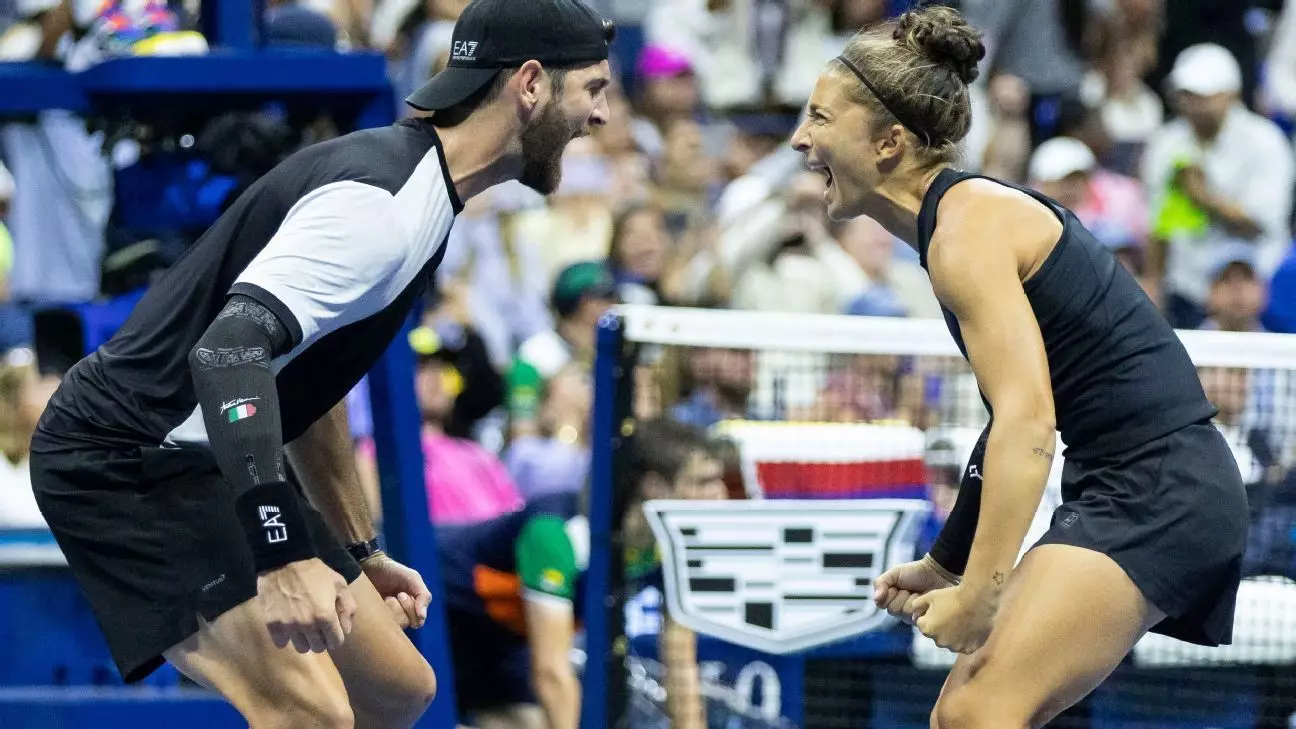The recent overhaul of the US Open mixed doubles event has ignited a firestorm of debate within the tennis community. Once a beloved fixture featuring traditional doubles teams and a showcase for doubles specialists, the tournament’s organizers opted for a radical reimagining. They prioritized attracting the sport’s biggest singles stars by reshaping the event into a condensed, high-stakes spectacle held prior to the main singles draw. The move was driven by a desire to boost audience engagement, elevate the tournament’s profile, and generate more revenue—an ambitious gamble that, whether intended or not, has challenged the very essence of doubles tennis.
Critics immediately questioned whether this shift preserved the sport’s integrity, arguing it transformed a cherished team discipline into a mere sideshow. Yet, amidst skepticism, a narrative of resilience and rediscovery gradually emerged. The triumph of Sara Errani and Andrea Vavassori serves as a testament to the resilience of traditional doubles play and the human capacity to adapt in the face of change.
This newly forged stage proved that with passion, skill, and a collective belief, underdog stories can flourish even amidst upheaval. The tournament became a crucible, testing the spirits of players who refused to be eclipsed by the spectacle of singles stars. The Italians, once considered on the fringes of the main event landscape, defied expectations—redefining what success in doubles can look like in a tournament that seemed to sideline them.
Underdogs Claim the Spotlight: A Lesson in Spirit and Skill
Errani and Vavassori’s victory is not just a tale of perseverance; it is an affirmation that the core of tennis—connectivity, teamwork, and tactical brilliance—remains vital. Their journey, marked by a grueling schedule and battling skepticism, culminated in a historic win against top seeds Iga Swiatek and Casper Ruud. The Italians’ victory was more than a scoreline; it embodied a statement that doubles tennis, often sidelined for singles grandeur, possesses its own unique allure and depth.
Their success was rooted in mastery of doubles fundamentals—sharp net play, deft teamwork, and strategic placement—elements often overshadowed by the raw power of singles. Vavassori’s height and agility at the net disrupted the baseline precision of Swiatek and Ruud, who are both exceptional singles players. Errani’s experience and tactical acumen provided the necessary edge, turning the match into a showcase of how doubles requires a different set of skills—anticipation, coordination, and psychological resilience. The Italians’ win is a clarion call that doubles should not be merely an afterthought but an integral part of tennis’s diverse universe.
The victory also underscores an essential truth: that passion and dedication can defy expectations, even within a sport that often venerates individual achievement over teamwork. Errani and Vavassori’s journey reminds us that there is an innate beauty in the craft of doubles—a dance that combines strategy, agility, and chemistry—qualities that cannot be replaced by stars alone.
Changing Perspectives: From Skepticism to Celebration
The reshuffled format, with its short sets and condensed schedule, drew widespread criticism. Detractors argued that the tournament risked sacrificing the sport’s depth and tradition for fleeting spectacle. Yet, the reactions of players and fans at Arthur Ashe Stadium tell a different story. For many, this new iteration of the event offered an electrifying experience—an opportunity to witness elite-level doubles play in a more accessible, high-energy setting.
The crowd’s enthusiasm was palpable. Packed stands, roaring applause, and intense energy turned the night into an affirmation that tennis’s heartbeat still lies in its ability to surprise and excite. Even players who are primarily doubles specialists or singles purists could not deny the compelling atmosphere. Christian Harrison’s exuberant comments about the night exemplify how innovative formats can evoke fresh appreciation for the sport.
Moreover, the performance of top singles champions like Swiatek and Ruud during the event illuminated an intriguing dynamic: that competitive spirit and strategic acumen in doubles can complement, rather than compete with, singles excellence. Swiatek’s and Ruud’s ability to adapt under pressure, fighting back in battles like the match tiebreak, demonstrates that the traditional dichotomy between singles and doubles is more porous than often assumed. Their participation lent credibility to the event’s legitimacy, even if it challenged conventional expectations.
This experiment in tournament design prompts a vital question: can tennis evolve while honoring its roots? The answer may be yes if success is measured not just in traditional terms but in the ability to ignite passion, broaden audiences, and inspire players at all levels.
Reimagining a Legacy: The Future of Doubles in a New Era
While the protestations of purists remain valid, the results from this revamped US Open event suggest a compelling new pathway for doubles. The triumph of Errani and Vavassori proves that the soul of the game persists beyond formats and scheduled timings. Their victory exemplifies resilience—a reminder that their discipline, often overshadowed by singles stars, possesses an undeniable allure that can energize audiences and elevate the sport as a whole.
The event’s success in drawing near-capacity crowds signifies that fans crave unpredictable, compelling tennis narratives—stories that feature not only star power but also grit, teamwork, and strategic brilliance. If organizers listen to the pulse of the crowd and players, future iterations could blend the best of both worlds: preserving rich traditions while embracing innovation.
In the end, Errani and Vavassori’s story challenges tennis to think beyond conventional paradigms. Their win underscores a vital insight: that the heart of tennis beats strongest when it values diversity—whether in playing styles, tournament formats, or narratives of underdogs rising to claim their rightful place. It’s a reminder that sometimes, the most profound victories are born from unexpected places,

